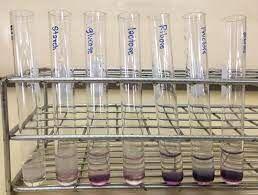Molisch’s Test is a sensitive group test used regularly to detect all carbohydrates in free or combined form. Monosaccharides react rapidly, whereas disaccharides and polysaccharides react slowly.

Principle:
This test uses concentrated H2SO4 to catalyze the dehydration of sugars to form hydroxymethyl furfural (from hexoses) or furfural (from pentoses). The furfurals then condense with α-naphthol to give a violet or purple-colored product.
Reagents Required
i. Conc. sulfuric acid
ii. Molisch’s Reagent: 5% α-naphthol solution in 95% ethanol
iii. Carbohydrates (glucose, maltose)
Procedure
- Add 1-2 ml of unknown solution in a test tube.
- Add 2-3 drops of Molisch’s reagent ad mix well.
- Hold the test tube inclined and carefully add 1-2 ml of Conc. Sulfuric acid down the side of the tube to make a layer of it at the bottom of the tube.
Result:
The formation of a purple product/ring at the border of two layers indicates a positive test.

Applications
The applications of Molisch’s Test extend beyond carbohydrate chemistry. In biochemistry and biology, this test is used to detect the presence of carbohydrates in biological samples, including plant tissues and microorganisms.
Moreover, industries utilize Molisch’s Test for quality control in various food and beverage products, pharmaceuticals, and agricultural products.
Limitations and Interferences
While Molisch’s Test is widely used, it has certain limitations and interferences that must be considered. Factors such as pH, temperature, and interfering substances can affect the test results.
For instance, substances containing phenolic groups can interfere with the reaction, leading to false-positive results. Careful consideration of these factors is necessary to ensure accurate interpretations.
Significance in Carbohydrate Chemistry
Molisch’s Test holds excellent significance in carbohydrate chemistry, particularly for detecting and identifying various sugars. The test can detect both simple and complex carbohydrates, making it a versatile tool for researchers in the field.
Scientists can even identify specific types of sugars present in a sample by utilizing specific modifications to the test procedure.
Variations and Modifications
Over time, researchers have developed modified versions of Molisch’s Test to overcome its limitations and cater to specific needs.
These modifications involve using different reagents, altering reaction conditions, or incorporating additional steps.
Additionally, alternative tests for carbohydrate detection, such as Benedict’s and Fehling’s tests, offer comparable results and serve as alternatives in certain situations.
Advantages and Disadvantages
Molisch’s Test offers several advantages. It is a relatively simple and rapid test that provides qualitative information about the presence of carbohydrates.
It can be performed with readily available reagents and equipment. However, the test has some disadvantages. It is unsuitable for quantitative analysis, and the violet color produced can fade over time, making long-term observations challenging.
FAQs
Can Molisch’s Test detect all types of sugars?
Molisch’s Test can detect various sugars, including simple and complex carbohydrates. However, the test may not provide specific information about the type of sugar present. Modified versions or complementary tests may be necessary for more precise identification.
How long does the test take to perform?
The test can be completed within a few minutes, making it a quick and efficient method for carbohydrate detection. The exact time may vary depending on the sample and the protocol.
Can Molisch’s Test be used for non-carbohydrate compounds?
While Molisch’s Test is primarily designed for carbohydrate detection, it can react with other compounds containing reactive hydroxyl groups. However, this may lead to false-positive results or interfere with the interpretation of the test.
Can Molisch’s Test be used for quantitative analysis?
Molisch’s Test is not suitable for quantitative analysis due to the subjective nature of color observation. Quantitative determination of carbohydrates often requires more precise methods, such as spectrophotometry or chromatography.
Read also
